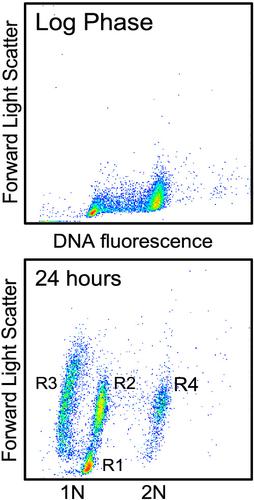Our official English website, www.x-mol.net, welcomes your
feedback! (Note: you will need to create a separate account there.)
The budding yeast transition to quiescence
Yeast ( IF 2.2 ) Pub Date : 2020-12-22 , DOI: 10.1002/yea.3546 Shawna Miles 1 , Graham T Bradley 2 , Linda L Breeden 1
Yeast ( IF 2.2 ) Pub Date : 2020-12-22 , DOI: 10.1002/yea.3546 Shawna Miles 1 , Graham T Bradley 2 , Linda L Breeden 1
Affiliation

|
A subset of Saccharomyces cerevisiae cells in a stationary phase culture achieve a unique quiescent state characterized by increased cell density, stress tolerance, and longevity. Trehalose accumulation is necessary but not sufficient for conferring this state, and it is not recapitulated by abrupt starvation. The fraction of cells that achieve this state varies widely in haploids and diploids and can approach 100%, indicating that both mother and daughter cells can enter quiescence. The transition begins when about half the glucose has been taken up from the medium. The high affinity glucose transporters are turned on, glycogen storage begins, the Rim15 kinase enters the nucleus and the accumulation of cells in G1 is initiated. After the diauxic shift (DS), when glucose is exhausted from the medium, growth promoting genes are repressed by the recruitment of the histone deacetylase Rpd3 by quiescence‐specific repressors. The final division that takes place post‐DS is highly asymmetrical and G1 arrest is complete after 48 h. The timing of these events can vary considerably, but they are tightly correlated with total biomass of the culture, suggesting that the transition to quiescence is tightly linked to changes in external glucose levels. After 7 days in culture, there are massive morphological changes at the protein and organelle level. There are global changes in histone modification. An extensive array of condensin‐dependent, long‐range chromatin interactions lead to genome‐wide chromatin compaction that is conserved in yeast and human cells. These interactions are required for the global transcriptional repression that occurs in quiescent yeast.
中文翻译:

出芽酵母转变为静止状态
稳定期培养中的酿酒酵母细胞亚群达到独特的静止状态,其特征是细胞密度增加、应激耐受性和寿命增加。海藻糖的积累是必要的,但不足以赋予这种状态,并且不会因突然饥饿而重现。达到这种状态的细胞比例在单倍体和二倍体中差异很大,可以接近 100%,表明母细胞和子细胞都可以进入静止状态。当从培养基中吸收大约一半的葡萄糖时,转变开始。高亲和力葡萄糖转运蛋白开启,糖原储存开始,Rim15 激酶进入细胞核,G1 期细胞开始积累。双轴转变 (DS) 后,当培养基中的葡萄糖耗尽时,生长促进基因会因静止特异性阻遏物招募组蛋白脱乙酰酶 Rpd3 而受到抑制。DS 后发生的最终分裂是高度不对称的,G1 停滞在 48 小时后完成。这些事件的发生时间可能有很大差异,但它们与培养物的总生物量密切相关,表明向静止的转变与外部葡萄糖水平的变化密切相关。培养7天后,蛋白质和细胞器水平发生巨大的形态变化。组蛋白修饰存在全局变化。一系列广泛的依赖于凝缩蛋白的长距离染色质相互作用导致全基因组染色质压缩,这在酵母和人类细胞中是保守的。这些相互作用是静止酵母中发生的全局转录抑制所必需的。
更新日期:2021-02-10
中文翻译:

出芽酵母转变为静止状态
稳定期培养中的酿酒酵母细胞亚群达到独特的静止状态,其特征是细胞密度增加、应激耐受性和寿命增加。海藻糖的积累是必要的,但不足以赋予这种状态,并且不会因突然饥饿而重现。达到这种状态的细胞比例在单倍体和二倍体中差异很大,可以接近 100%,表明母细胞和子细胞都可以进入静止状态。当从培养基中吸收大约一半的葡萄糖时,转变开始。高亲和力葡萄糖转运蛋白开启,糖原储存开始,Rim15 激酶进入细胞核,G1 期细胞开始积累。双轴转变 (DS) 后,当培养基中的葡萄糖耗尽时,生长促进基因会因静止特异性阻遏物招募组蛋白脱乙酰酶 Rpd3 而受到抑制。DS 后发生的最终分裂是高度不对称的,G1 停滞在 48 小时后完成。这些事件的发生时间可能有很大差异,但它们与培养物的总生物量密切相关,表明向静止的转变与外部葡萄糖水平的变化密切相关。培养7天后,蛋白质和细胞器水平发生巨大的形态变化。组蛋白修饰存在全局变化。一系列广泛的依赖于凝缩蛋白的长距离染色质相互作用导致全基因组染色质压缩,这在酵母和人类细胞中是保守的。这些相互作用是静止酵母中发生的全局转录抑制所必需的。









































 京公网安备 11010802027423号
京公网安备 11010802027423号